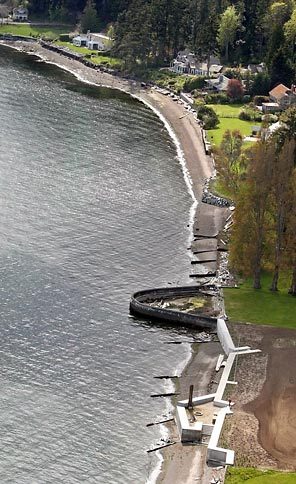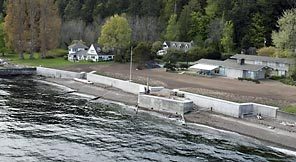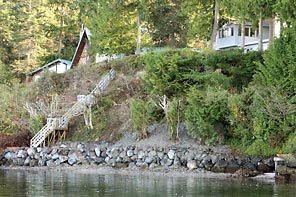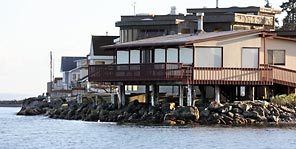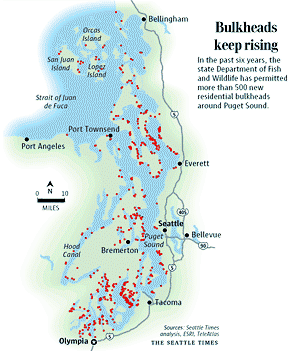Originally published May 13, 2008 at 12:00 AM | Page modified May 13, 2008 at 6:46 PM
Beaches suffer as walls go up
Every year the wall around Puget Sound keeps growing. On beach after beach, barriers of concrete and boulders are erected to keep the Sound...
Seattle Times staff reporters
STEVE RINGMAN / THE SEATTLE TIMES
Bulkheads snake along Puget Sound, protecting expensive homes on the south end of Bainbridge Island.
STEVE RINGMAN / THE SEATTLE TIMES
These Bainbridge homes are protected by a seawall. Scientists agree bulkheads and seawalls degrade rich near-shore habitat, but still the walls go up.
STEVE RINGMAN / THE SEATTLE TIMES
Piles of rock protect three homes on Bainbridge Island. Island government is trying to enforce rules to decrease bulkheads, but it isn't always effective.
STEVE RINGMAN / THE SEATTLE TIMES
Bulkheads and other man-made barriers cover half of Bainbridge Island's 53 miles of shoreline, according to a 2004 study. The walls, often made of concrete or rocks, have damaged habitat there by covering parts of beaches and tidal zones, the study found.
Failing our Sound
- Audio Slideshow | Eiichi "Jerry" Yamashita, oyster farmer
- Graphic | How development harms Puget Sound (PDF)
- Graphic | How wetlands keep Puget Sound healthy (PDF)
- Graphic | How wetlands keep Puget Sound healthy (PDF)
- Would you pay more to protect Puget Sound?
- Are we striking the right balance between protecting the Sound and making room for growth?
- Saving Puget Sound... again
Join the discussion
Wednesday at noon, join us for a live webcast and interactive chat about the future of Puget Sound. Local business, government and environmental leaders will take your questions.
Tuesday | Q&A with stormwater and shoreline experts: What can you do at your house to help?
Curtis Hinman, a watershed ecologist with Washington State University Extension office in Pierce County and Jim Brennan, a marine habitat specialist answered questions about things you can do to protect Puget Sound.
Every year the wall around Puget Sound keeps growing.
On beach after beach, barriers of concrete and boulders are erected to keep the Sound from washing away valuable real estate.
Stretched end to end, the barriers would already reach more than800 miles — enough to line both sides of Interstate 90 from Seattle to Spokane, with plenty to spare. In the past two years alone, that wall has grown at least another five miles.
The wall goes up in bits and pieces from one end of the Sound to the other, from million-dollar waterfront homes on Bainbridge Island to vacation getaways in the San Juan Islands.
The wall keeps growing even though scientists say it hurts the Sound by degrading some of the richest near-shore habitat, including spawning grounds of little fish critical to bigger predators like salmon. It grows even as millions of tax dollars are spent to tear down other walls.
For more than 30 years, we have been promising to change and passing laws to protect the Sound's 2,500 miles of shoreline. As a result, it's harder to get permission to build a bulkhead, as these walls are known. And the new ones usually aren't as destructive.
Yet the walls keep going up.
A Seattle Times analysis shows new bulkheads today are being built just as fast as they were a decade ago. In the past four years, the state Department of Fish and Wildlife has granted 456 permits for new bulkheads on Puget Sound. That doesn't include the old bulkheads people want to rebuild.
The number it has rejected: zero.
Why? A thirst for grand views and big homes. And the impulse to stop Mother Nature's erosion when it threatens a home, and when a half-acre of waterfront land can sell for $1 million.
It's also because of legal loopholes and out-of-date rules, and because we haven't always enforced the ones we have.
"Let's just be transparent about this and honest," said Jim Brennan, a biologist who used to review bulkhead permits for the state Fish and Wildlife Department.
"We're not stopping it."
Island's loopholes
Bainbridge Island is typical. Over the years, as the island went affluent and modest cottages in the woods gave way to waterfront estates, beaches have been fortified to save every valuable inch of real estate.
The city government is known as one of the strictest when it comes to bulkheads. But the city is still giving out permits — the staff doesn't track how many.
At Agate Passage, on the island's western shore, a new home is perched above the water. A freshly piled wall of rock runs roughly 230 feet along the beach, a fortification against the lapping water of Puget Sound.
It's also an example of how even get-tough regulations can be circumvented.
To stop the demand for new bulkheads, the island's government requires everyone who builds a waterfront home to get an engineer to vouch that the home won't need a bulkhead.
When the Agate Passage home was permitted in 1999, the city allowed it only after getting that promise. But a few years later, the city received a permit application for a rock wall for that house and a neighboring one. This time an engineer strongly recommended one.
"The cynical side of me says it's a long-term strategy by the developer to get to do something," said Peter Best, head of the city's shoreline-stewardship program, who said he has encountered several similar cases.
But Garrett Larsen, the Bainbridge Island architect who owns the house, said that erosion had worsened since the house was built, and that he still had a right to protect his property.
"We'd lost a lot of ground," he said.
A haven among walls
On a clear morning last fall, a boatload of scientists motored along Bainbridge Island's fortified edge, headed to the newest front line in the local struggle over shorelines.
They passed rows of concrete and rock walls. Groomed lawns extended from massive homes to the water's edge.
Finally, they pulled up to a beach at the base of a steep slope overgrown with trees and bushes. It was a cool haven from the sun. Big alder trees grew down at the edge of the sand, branches extending over the water and shading the eggs of tiny fish.
The scene could be doomed. The five landowners who have houses near the top of the bluff above are suing to be allowed to build 420 feet of bulkhead on this spot.
Even on Bainbridge Island, the city is still willing to give out bulkhead permits as it struggles to find a balance between protecting beaches and people's homes. And when property owners are told no by another agency, the result can be a blizzard of lawsuits.
The city decided to let three of the five property owners build bulkheads. The state Fish and Wildlife Department said OK to all five.
In most cases, that would be the end of the story. But because of a quirk in city rules, the project needed the endorsement of the state Department of Ecology. Ecology managers told the homeowners no.
The state officials argued that the bluffs are an important source of sand for the island's beaches, and the homeowners hadn't tried hard enough to find a less-destructive way to protect the land.
Best, the Bainbridge Island official, doesn't dispute Ecology's decision. He said the city didn't have the expertise to question claims made by the landowners' engineer.
The property owners are trying to design a less-massive bulkhead.
But they have also appealed the decision in court. They argue the city's rules allow the bulkhead, that it won't hurt the environment and that their land is at serious risk. One person's house is just 15 feet from the edge of the bluff.
Leonel Stollar, one of the five landowners, fears erosion will claim his septic drain field, destroying his sewer system.
"That would make my house almost valueless," he said.
Starved beaches
Bulkheads can hurt beaches and shallow-water environments, which are some of the richest pockets of life in the Sound.
The walls starve beaches of sand coming down from hillsides that would replenish sand washed away by waves. That results in shrunken, eroded beaches with less room for important shoreline life, such as sand lance and surf smelt, little fish that lay their eggs in the sand.
Those fish are important food for bigger fish, such as salmon, which in turn feed orcas and other animals.
When shoreline trees and bushes are mowed down for lawns and waterfront views, that takes away a source of insects that fall in the water and feed young salmon and of shade that cools fish eggs. Far fewer surf-smelt eggs survive on unshaded beaches, studies have found.
"We've lost an enormous amount of this habitat," said Hugh Shipman, a coastal geologist with the state Department of Ecology.
Hard, not impossible
The people of Washington decided nearly 40 years ago that shorelines should be protected.
In 1972, voters approved by referendum the Shoreline Management Act. It was meant to halt the damage that a century of unregulated shoreline construction had wrought. It declared that "shorelines of the state are among the most valuable and fragile of its natural resources."
As a result of that law, it is harder to build bulkheads.
But not impossible.
"If you've got enough money and you've got the horsepower, you can still put in a bulkhead," said Russell Trask. "But it will take you a year or two."
He should know. Trask boasts that over the decades, his company, Bainbridge Marine Services, built more than 1,000 bulkheads along Puget Sound. For Trask, the 1960s were the good old days, when he could fortify a beach with virtually no pesky bureaucrats getting in the way.
Trask finally shut down his company a few years ago, shortly after he was acquitted on criminal charges of building bulkheads without proper permits.
The bulkheads built today usually aren't as destructive as a generation ago, when they were put farther out into the water, claiming more habitat.
The number of Puget Sound bulkhead permits issued by the state Department of Fish and Wildlife dropped almost in half between the late 1980s and mid-1990s, from more than 200 a year to slightly more than 100, according to a Seattle Times analysis.
But since the mid-1990s, there's been little change in how many permits are given out, despite some new rules governing shoreline development and the 1999 listing of Puget Sound chinook under the Endangered Species Act. The walls still get built in part because the state shoreline law gives homeowners special treatment; there are fewer restrictions on big commercial or government landowners' ability to build bulkheads in front of houses.
Bulkheads were barely a concern when the Shoreline Management Act passed, said Joan Thomas, an environmental activist who helped lead the campaign for it.
"They were everywhere," she said of the bulkheads. "I don't think that the science of habitat was as well-understood."
On top of that, how strict the rules are depends partly on which county or city you're in.
The state shoreline act leaves most decisions about bulkheads to local government. Some of those governments will work aggressively to determine whether a bulkhead is needed. But others are more relaxed about it, Shipman says.
In many communities, the rules haven't been updated since the 1970s. The state Legislature recently has mandated revisions, but in many cases that won't happen until 2011 or 2012.
Even the new rules are only as strong as local bureaucrats make them, warned Doug Myers, science director for the environmental group People for Puget Sound, and previously a lead scientist with the state's Puget Sound Action Team.
"You can look at the words, and a lot of times the words are great. But then there's all these requests for variance and stuff," he said. "It's still up to the locals to do the day-to-day management to make sure that it happens."
Agency hamstrung
The state Department of Fish and Wildlife is also supposed to have a say over bulkheads, issuing a separate permit from the one local governments give. But the department's own leaders admit they aren't doing enough.
In part, the Legislature has whittled away the agency's power, at the urging of landowners and businesses.
In 1991, a group of bulkhead builders, including Trask, successfully lobbied the Legislature to forbid the department from rejecting any bulkhead permits for single-family homes. The department can still place conditions on permits to try to lessen the damage.
Then in 2002, the Legislature ordered a task force to look at the way the department handles bulkhead applications. One of the main goals was to get the department to approve them faster.
Such pressure to speed things up, combined with staff shortages, leaves little time to review projects to make sure no actual environmental harm would be done, complains Greg Hueckel, Fish and Wildlife's assistant director overseeing the permit program.
"I liken it to a county that issues building permits without building inspectors," Hueckel said.
In 2006, the department did its first audit to see how well the permits were protecting the environment. The results weren't encouraging.
Despite a state law requiring new bulkheads to be designed so they won't hurt fish habitat, damage continues.
"In other words," Tim Quinn, Fish and Wildlife's chief habitat scientist, told state lawmakers at a hearing last November, "we're not doing a very good job."
Warren Cornwall: 206-464-2311 or wcornwall@seattletimes.com
Copyright © 2008 The Seattle Times Company
UPDATE - 09:46 AM
Exxon Mobil wins ruling in Alaska oil spill case
NEW - 7:51 AM
Longview man says he was tortured with hot knife
Longview man says he was tortured with hot knife
Longview mill spills bleach into Columbia River
NEW - 8:00 AM
More extensive TSA searches in Sea-Tac Airport rattle some travelers

general classifieds
Garage & estate salesFurniture & home furnishings
Electronics
just listed
More listings
POST A FREE LISTING


